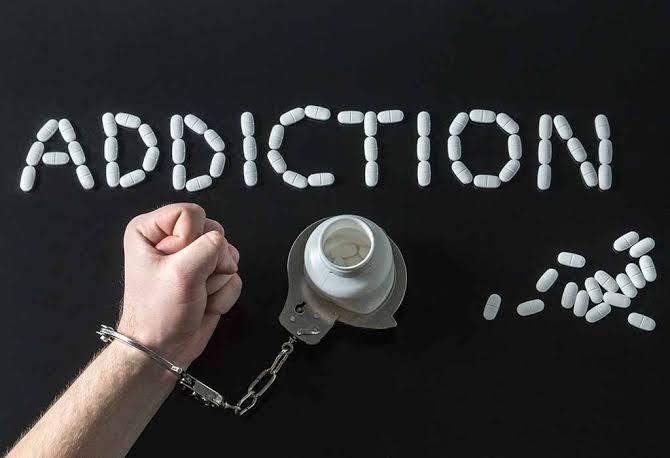Written by: Omolola Amosu

Addiction is a plague that affects individuals and society in an adverse manner. It is a very costly illness that has worldwide prevalence.
What is Addiction?
Addiction refers to persistent, repetitive and often irresistible self destructive activity that, at its beginning, is perceived as rewarding. It involves addictive behaviour that once learnt becomes difficult to get rid of despite its negative consequences on the individual and their environment.
The term addiction is often used to refer to physiological dependence on the substance.
Addiction is not a character flaw nor a personality disorder.
Addiction is a chronic relapsing brain disease that is characterized by compulsive substance seeking and use, despite its harmful consequence.
It is rather a chronic health problem which may not be completely cured but managed.
Genetics determine about 50 percent of drug and alcohol addiction risk while Environment determines the other 50 percent. That means 50% addiction rate for individuals is determined by their Genetics makeup ie what was inherited from their parents and the other 50% from environmental factors they are exposed to.
Women are more susceptible to addiction.
Lets use Alcohol as an example.
Compared with men, women experience significantly shorter time intervals between the initiation of alcohol use and the onset of significant alcohol related problems and treatment entry. This accelerated course, is known as TELESCOPING.
Telescoping may be attributed to a variety of biological, socioeconomic, psychological, and cultural factors that affect women.
A woman’s body contains less water and more fatty tissue than a man’s body. Because fat retains alcohol while water dilutes it, a woman’s organs sustain greater exposure. In addition, women have lower levels of two enzymes — alcohol dehydrogenase and aldehyde dehydrogenase — that break alcohol down in the stomach and liver. As a result, women absorb more alcohol into the bloodstream
Gender differences in motives for alcohol use have been observed
with women being more likely than men to consume alcohol in response to stress and negative emotions.
In contrast, men seem more likely than women to consume alcohol to enhance positive emotions or to conform to a group.
Women are less likely than men to seek treatment, and more likely to face barriers during treatment. Some of this barriers are childcare responsibilities, transportation, financial status, and social stigma.
Types of Addiction
1. Behavioural Addiction
This is a form of addiction that involves a compulsion to engage in a rewarding non- substance -related behavior – sometimes called a natural reward despite any negative consequences to the person’s physical, mental, social or financial well-being Examples are Gambling disorder, Sex addiction, Shopping Addiction, Self Cutting, Internet Addiction, Food Addiction, Nail Biting, Obsessive hand washing and so on.
2. Substance Use Disorder(SUD’s) or Drug Addiction.
It is the persistent use of drugs( alcohol) despite substantial harm and adverse consequences. It is a disease that affects a person’s brain and behavior and leads to an inability to control the use of a legal or illegal drug or medication. Drug abuse can leads to drug addiction.
Our discuss will focus on Substance Use Disorder
Substance Use Disorder
Substance abuse refers to the harmful or hazardous use of psychoactive substances, including alcohol and illicit drugs.
What are Psychoactive Substances?
They are chemical substances that changes brain function and results in alterations in perception, mood, consciousness, cognition, or behavior.
The use of psychoactive substance can lead to dependence syndrome – a cluster of behavioural, cognitive, and physiological phenomena that develop after repeated substance use and that typically include a strong desire to take the drug, difficulties in controlling its use, persisting in its use despite harmful consequences, a higher priority given to drug use than to other activities and obligations, increased tolerance, and sometimes a physical withdrawal state
Example of psychoactive substances are
- Marijuana,
- Coffee
- Cannabis
- Cocaine
- Ecstacy
- Alcohol
- Tobacco
- Valium
- Mushroom
- Nicotine
- Colorado
- Skunk and so on
Use of psychoactive substances by individuals follow a pattern from the period of abstinence where there is no involvement with drugs to the time of dependence and over dependence on the use of psychoactive compounds. The psychoactive compound use pathway are started
- Abstinence
- Experimental/ Recreational use
- Occasional use
- Regular use
- Addictive use.
immediate causes of Substance uses includes the following
- Depression
- History of trauma.
- Stress and Inability to cope with stress.
- Low self esteem
- Social pressure
- Academic pressure
- Lack of parent – childcommunication.
Drug Abuse in Nigeria.
Drugs have street Names.
PREVENTION THEY SAY IS BETTER THAN CURE
Lets take a look at how drugs can be prevented by mentioning the approaches that can be engaged to prevent the onset of drug use.
Family Based Prevention.
Parental supervision and involvement are critical in adolescents. Parents must not only have a plan to educate their children on the dangers of drug use and abuse, but they must also establish and enforce family rules. This includes creating an effective system of monitoring their children’s activity.
School Based Drug Abuse Prevention Programs.
Middle and high school programs should focus on peer relationships, communication, assertiveness, drug resistance skills and developing anti-drug attitudes. School based prevention programs should be repeated often for the best level of success
I want to establish that not all persons who abuse drugs would become addicted.
But Women tend to progress more quickly from using an addictive substance to dependence (a phenomenon known as telescoping).
Warning signs to look at for.
There are general signs and there are also specific signs depending on the drugs.
The signs and symptoms of substance use disorder can vary with the individual, the substance they are overusing, their family history, and their personal circumstances
General Signs for Adolescents- Secretive behaviours-
- Laughing for no reason.
- School problems such as declining or failing grades, poor attendance and recent discipline problems
- Bloodshot eyes
- Overconfidence
- Loss of interests on hobbies/favorites activities
- Deteriorating relationships with family members and friends
- Changing in sleeping or eating pattern
- Frequent arguments
- Sudden mood changes and unexplained violent actions
- Depressed mood or talk about depression or suicide
General signs for Adults- Changes in personality and behavior like a lack of motivation, irritability, and agitation
- Problems with the law
- Bloodshot eyes and frequent bloody noses
- Shakes, tremors, or slurred speech
- Change in their daily routines
- Lack of concern for personal hygiene
- Unusual need for money
- financial problem
- Changes in friends and activities.
Some signs of specific drugs
Marijuana
Cocaine
Ecstasy
*excessive sweating
Alcohol
* Hand tremor
Now to this Question
what can we do to help especially the young ones?
In Nigeria, its a taboo to talk about drug abuse or drug addiction. Most people do not talk about it mostly because of stigmatization.
Awareness is key.
The stake holders are parents, school administrators, religious organizations, Law enforcers, legislative bodies. In a country like Nigeria that is still developing, the focus today would be on the family unit.
Family unit
The first step would be to equip ourselves with adequate knowledge about drugs. If possible to be aware of the ever changing street names of those drugs, the telltale signs of drug use.
Parents can influence their children’s choices enough to make a difference. Parents play a major role in preventing substance abuse among youth and in helping them if they’ve initiated use.
Talking with a child about the dangers of substance use and showing disapproval of such behavior are key to shaping children’s attitudes and behaviors.
Staying involved in a child’s day-to-day activities is also critical. Some steps that parent can take includes
- Learn the major risk factors for drug use among children.(genetics (history of such in the family), low self esteem, high or low socioeconomic favors and so on.
- Learn about drug use consequences and make clear statements that you disapprove of drug use.
- Be involved in your child’s life.
- Know your child’s friends.
- Minimize a child’s stress at home.
- Learn the signs of a child’s drug use and how to respond.
- Set good examples. Children notice how parents use alcohol, tobacco, and drugs at home and in their social life
- Parent can also teach their children on major skills like decision making, assertiveness, strong moral values, good self esteem and so on
- Role play-Parents can take a drama role as their children friend in a play They paint a scenario that urges or pressure their children to take drugs. They both develop series of answers that the child may use when offered drugs to refuse it assertively Here the child learns how to refuse the drug offer.This prepares the child for any occasion when such occurs.
- Roles can be switched. Role play has many benefits. It prepares children with ready answers should in case they are being offered drugs. It also opens the line of communication between parent and children.
- Also we can’t over emphasize the power of a praying parent.
Addiction is not just an individual, family problem.
It is a community problem. Prevention is better than cure but the bad thing is that there is not cure for drug addiction. It can only be managed.
The addiction problem is prevalent among adolescents who in most cases are ignorant about the dangers inherent in drug abuse. …..
The best time to make a difference in the younger generation is Now
Lets raise awareness, Ignorance is bad, Knowledge is power.
Thank you and God bless
For enquires contact: info@ptwritershub.com

Now is time to shine the Light
Brilliant 👍
Knowledge is Power!
Every form of addiction is bad, no matter whether the narcotic is alcohol, morphine, or idealism.